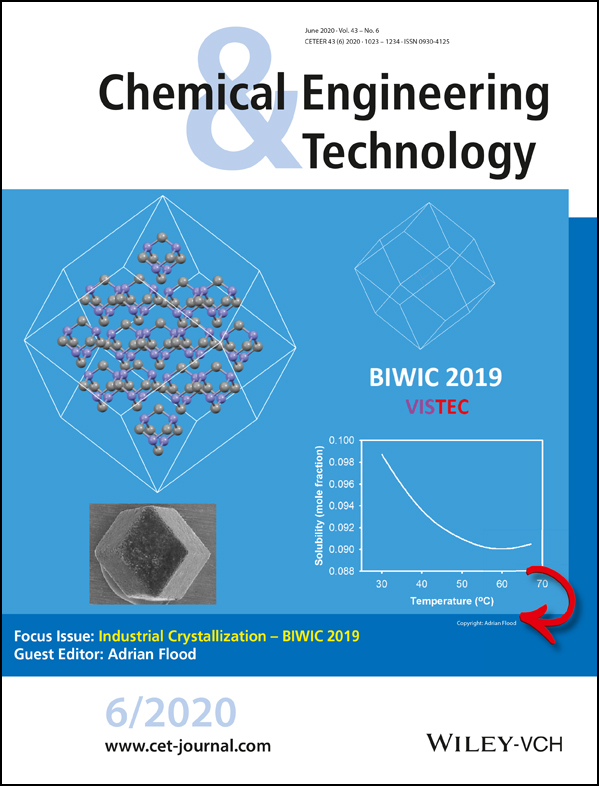Partial Seeding Policy for Controlling the Crystal Quality in Batch Cooling Crystallization
Corresponding Author
Joi Unno
Waseda University, Department of Applied Chemistry, School of Advanced Science and Engineering, 3-4-1 Okubo, Shinjuku, 169-8555 Tokyo, Japan
Correspondence: Joi Unno ([email protected]), Waseda University, Department of Applied Chemistry, School of Advanced Science and Engineering, 3-4-1 Okubo, Shinjuku, 169-8555 Tokyo, Japan.Search for more papers by this authorIzumi Hirasawa
Waseda University, Department of Applied Chemistry, School of Advanced Science and Engineering, 3-4-1 Okubo, Shinjuku, 169-8555 Tokyo, Japan
Search for more papers by this authorCorresponding Author
Joi Unno
Waseda University, Department of Applied Chemistry, School of Advanced Science and Engineering, 3-4-1 Okubo, Shinjuku, 169-8555 Tokyo, Japan
Correspondence: Joi Unno ([email protected]), Waseda University, Department of Applied Chemistry, School of Advanced Science and Engineering, 3-4-1 Okubo, Shinjuku, 169-8555 Tokyo, Japan.Search for more papers by this authorIzumi Hirasawa
Waseda University, Department of Applied Chemistry, School of Advanced Science and Engineering, 3-4-1 Okubo, Shinjuku, 169-8555 Tokyo, Japan
Search for more papers by this authorAbstract
Partial seeding, in which the nuclei originating from seed crystals grow to yield the product crystals, was simulated and optimized for controlling the batch cooling crystallization process of L-arginine. The product quality was evaluated by the coefficient of variation (CV) of the crystal size distribution. First, the optimum seed amount for partial seeding was estimated by simulation. Then, the simulated values of the optimum seed amount and the resulting local minimum CV were correlated with the seed crystal size and the cooling rate. The correlation can be utilized for estimating the seed amount in the case that the seed crystals are added in a slurry. Finally, these simulated values were compared to the measured ones. Consequently, the optimum seed amount was suggested to be reasonably predicted.
References
- 1 J. Wang, F. Li, R. Lakerveld, Chem. Eng. Process. 2018, 127, 111–126. DOI: https://doi.org/10.1016/j.cep.2018.03.018
- 2 S. Rohani, Front. Chem. Eng. China 2010, 4 (1), 2–9. DOI: https://doi.org/10.1007/s11705-009-0297-z
- 3 E. A. Martínez, E. V. Canettieri, J. A. C. Bispo, M. Giulietti, J. B. de Almeida e Silva, A. Converti, Sep. Sci. Technol. 2015, 50 (14), 2087–2098. DOI: https://doi.org/10.1080/01496395.2015.1009115
- 4 J. B. Rawlings, S. M. Miller, W. R. Witkowski, Ind. Eng. Chem. Res. 1993, 32 (7), 1275–1296. DOI: https://doi.org/10.1021/ie00019a002
- 5 J. Kukura, B. Izzo, C. Orella, Pharm. Technol. 2005, 29 (10), 80–86.
- 6 Y. Yoshimura, M. So, H. Yagi, Y. Goto, Jpn. J. Appl. Phys. 2013, 52 (7), 07HA01. DOI: https://doi.org/10.7567/JJAP.52.07HA01
- 7 T. Haasner, A. K. Kuszlik, R. Stadler, J. Ulrich, Chem. Eng. Technol. 2001, 24 (9), 873–878. DOI: https://doi.org/10.1002/1521-4125(200109)24:9<873::AID-2089873>3.0.CO;2-U
- 8 J.-W. Kim, J.-K. Kim, H.-S. Kim, K.-K. Koo, Org. Process Res. Dev. 2011, 15 (3), 602–609. DOI: https://doi.org/10.1021/op100334y
- 9 M. Lenka, D. Sarkar, J. Cryst. Growth 2018, 486, 130–136. DOI: https://doi.org/10.1016/j.jcrysgro.2018.01.029
- 10 N. Doki, N. Kubota, M. Yokota, A. Chianese, J. Chem. Eng. Jpn. 2002, 35 (7), 670–676. DOI: https://doi.org/10.1252/jcej.35.670
- 11 N. Kubota, N. Doki, M. Yokota, D. Jagadesh, J. Chem. Eng. Jpn. 2002, 35 (11), 1063–1071. DOI: https://doi.org/10.1252/jcej.35.1063
- 12 M. Lee, R. Geertman, M. Rauls, P. Daudey, Challenges in Industrial Crystallization, 19th Int. Symp. on Industrial Crystallization (ISIC 19), Toulouse, September 2014.
- 13 N. Kubota, N. Doki, M. Ito, S. Sasaki, M. Yokota, J. Chem. Eng. Jpn. 2002, 35 (11), 1078–1082. DOI: https://doi.org/10.1252/jcej.35.1078
- 14 N. Doki, M. Yokota, S. Sasaki, N. Kubota, J. Chem. Eng. Jpn. 2004, 37 (3), 436–442. DOI: https://doi.org/10.1252/jcej.37.436
- 15 D. J. Widenski, A. Abbas, J. A. Romagnoli, Comput. Chem. Eng. 2011, 35 (12), 2696–2705. DOI: https://doi.org/10.1016/j.compchemeng.2010.11.002
- 16 J. Unno, I. Hirasawa, J. Chem. Eng. Jpn. 2019, 52 (6), 501–507. DOI: https://doi.org/10.1252/jcej.18we272
- 17 M. Trampuž, D. Teslić, B. Likozar, Chem. Eng. Sci. 2019, 97–111. DOI: https://doi.org/10.1016/j.ces.2019.02.019
- 18 A. Pandit, V. Katkar, V. Ranade, R. Bhambure, Ind. Eng. Chem. Res. 2019, 58 (18), 7607–7619. DOI: https://doi.org/10.1021/acs.iecr.8b04613
- 19 W.-S. Kim, K.-K. Koo, Cryst. Growth Des. 2019, 19 (3), 1797–1804. DOI: https://doi.org/10.1021/acs.cgd.8b01771
- 20 A. Ruf, J. Worlitschek, M. Mazzotti, Part. Part. Syst. Charact. 2000, 17 (4), 167–179. DOI: https://doi.org/10.1002/1521-4117(200012)17:4<167::AID-PPSC167>3.0.CO;2-T
- 21 N. Kail, H. Briesen, W. Marquardt, Part. Part. Syst. Charact. 2007, 24 (3), 184–192. DOI: https://doi.org/10.1002/ppsc.200601036
- 22 J. Unno, R. Umeda, I. Hirasawa, Chem. Eng. Technol. 2018, 41 (6), 1147–1151. DOI: https://doi.org/10.1002/ceat.201700615
- 23 A. D. Randolph, M. A. Larson, Theory of Particulate Processes: Analysis and Techniques of Continuous Crystallization, 2nd ed., Academic Press, San Diego, CA 1988.
- 24 A. L. Nunis da Silva, M. M. Seckler, D. Odloak, Chem. Eng. Technol. 2018, 41 (7), 1406–1416. DOI: https://doi.org/10.1002/ceat.201800031
- 25 N. Kubota, J. Cryst. Growth 2008, 310 (3), 629–634. DOI: https://doi.org/10.1016/j.jcrysgro.2007.11.123
- 26 M. Kobari, N. Kubota, I. Hirasawa, J. Cryst. Growth 2010, 312 (19), 2734–2739. DOI: https://doi.org/10.1016/j.jcrysgro.2010.05.042
- 27 J. W. Mullin, Crystallization, 4th ed., Butterworth-Heinemann, Oxford 2001.
- 28 J. Unno, H. Kawase, R. Kaneshige, I. Hirasawa, Chem. Eng. Technol. 2019, 42 (7), 1428–1434. DOI: https://doi.org/10.1002/ceat.201800646
- 29 H. M. Hulburt, S. Katz, Chem. Eng. Sci. 1964, 19 (8), 555–574. DOI: https://doi.org/10.1016/0009-2509(64)85047-8
- 30https://jp.mathworks.com/help/matlab/ref/ode15s.html?lang=en (Accessed on November 15, 2019)
- 31 L. F. Shampine, M. W. Reichelt, SIAM J. Sci. Comput. 1997, 18 (1), 1–22. DOI: https://doi.org/10.1137/S1064827594276424
- 32https://jp.mathworks.com/help/matlab/ref/fminbnd.html?lang=en (Accessed on November 15, 2019)
- 33 T. P. Melia, W. P. Moffitt, J. Colloid Sci. 1964, 19 (5), 433–447. DOI: https://doi.org/10.1016/0095-8522(64)90043-1
- 34 N. Kubota, J. Cryst. Growth 2015, 418, 15–24. DOI: https://doi.org/10.1016/j.jcrysgro.2015.02.021
- 35 N. Kubota, Y. Fujisawa, T. Tadaki, J. Cryst. Growth 1988, 89 (4), 545–552. DOI: https://doi.org/10.1016/0022-0248(88)90217-5




